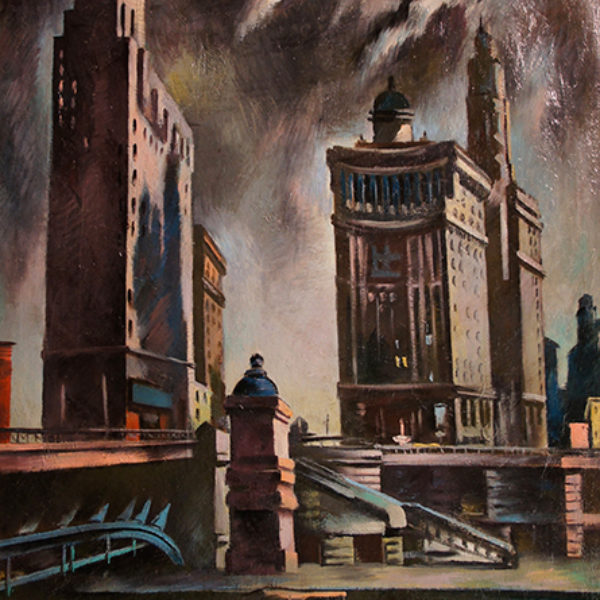Joseph Vavak
b. 1899, Vienna, Austria - d. 1969, Stotesbury, MO
Born in Vienna to parents of Bohemian background, Joseph Vavak left Europe for Chicago in 1904. His parents insisted that he study music, but a high school teacher helped him enroll in summer classes at the School of the Art Institute of Chicago (SAIC), where he where was a highly successful student from 1908 to 1916. To support his artistic interests, Vavak earned a living in both bands and orchestras. After serving in the Navy in World War I, he spent most of the 1920s in Chicago, often playing piano at the Dill Pickle Club, the famed nightspot for free-thinking artists, writers, anarchists, and Bughouse Square hobos. Vavak’s paintings were frequently exhibited in Art Institute of Chicago annual exhibitions from 1914 to 1945. His gently satirical illustrations also appeared in the Daily Worker, the newspaper of the Communist Party USA.
Vavak went to Paris to pursue further study in painting in August 1929, but the stock market crash brought him back to Chicago. During the Depression, Vavak was appointed to the mural and easel divisions of the Federal Art Project, and he continued to be affected by the plight of the poor and working classes. In 1937, Vavak produced a work inspired the autoworkers’ Sit-Down Strike of 1936–37, the Women of Flint, which was purchased by the Museum of Modern Art in New York. He described his work at the time:
Motivation must come from outside of one’s self. External conditions, economic and physical, have been so acute during the past few years they have compelled even the average minded student to a personal investigation. Although these are lean years for many a poor man’s stomach they are at the same time rich harvest for the creative urge.
Sterile form and color in painting do not seem to me to be of first importance. The artist’s mastery of both should be so perfect as to render them subservient (not usurping) in his earnest groping for the development of his subject. By interpreting a period which will become a poignant page in the history of America, and so that of the whole world, I hope to make some small contribution.
Vavak’s Chicago, 1940, shows four classic skyscrapers massed on either side of Michigan Avenue at the Chicago River: at left, 333 N. Michigan Avenue and the Old Republic Building; and at right, the London Guaranty Building and Mather Tower. Standing like dark sentinels against a stormy sky, these buildings—little more than ten years old when painted in 1940—look atavistic rather than modern. The ominous palette of greyed pinks and blues, as well as the turbulent sky, suggests an apocalyptic vision reminiscent of El Greco’s views of Counter-Reformation Toledo.
In First Defense, Vavak created a complex and enigmatic allegory, presented in a series of vignettes. Painted in 1941, it seems to be a cautionary report on the lack of U.S. readiness to participate in world events—specifically the war raging in Europe and Asia. Most of the figures appear as listless or innocent pawns, unaware of the larger drama being played out on the world stage. Below, a sleepy worker holds a broom, which strokes the surface of a phallic and vibrantly orange-colored smokestack. To the left, children play at being soldiers, and a doctor examines the health of four shirtless men. At upper right, a figure in a formal cutaway, his head and legs obscured, seems to call forth heads from a box as if he were a magician pulling rabbits out of hats. In the center, standing below a street sign that reads “Main Street” is an isolated young woman holding a child.
Vavak exhibited his work nationally throughout the 1940s and continued to paint in the 1950s and 1960s, even while he taught piano in Roselle, Illinois, just outside of Chicago. In 1963, Vavak and his wife retired to Florida.
Daniel Schulman
References
Hills, Patricia. Social Concern and Urban Realism: American Painting of the 1930s. Boston: Boston University Art Gallery, 1983.
Jacobson, J. Z. Art of Today, Chicago, 1933, p. 133. Chicago: L. M. Stein, 1933.
Vavak, Joseph, papers. Pamphlet file, P-22163. Ryerson Library. Art Institute of Chicago.

